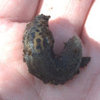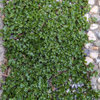Catterpillars in the Pacysandra
Hoib
9 years ago
I have a large 40 foot rectangular shape bed of pachysandra on the north facing side of our home, (NE US) next to the foundation. For the last 30 years, this bed has come back beautifully each spring. This year, I noticed that an oval area about 4 ft by 2 ft was forming in the middle. The next day that oval got bigger. Each succeeding day, it grew. The plants were horribly degraded, wilted, almost like something was burning them up. You could almost watch it grow. I took a stalk sample to my local garden center. There, as we unfolded a curled up dried leaf, we found a tiny 1-inch long caterpillar popped out of his hiding place. She gave me a systemic, told me to apply it only with a watering can. I followed the directions and liberally soaked the ground as best I could. The systemic also includes a general fertilizer.
The 40 foot bed is now 90% destroyed. I can only describe it as "Berlin after the Allies bomed it out...) I can now see dozens of these cats, climbing the walls of the house where I treated. Probably trying to get away from the systemic. I don't know that I've actually stopped them. It appears as though the 10% remaining are holding on.
Questions:
What else can I apply to get these off the plants?
Will these guys ever come back? Pacysandra are normally pretty resilient to such damage a tromping I have to do to get the leaves out each fall. You can't kill them! Except in this case...
What's my next move?
H



jean001a
HoibOriginal Author
Related Professionals
Barrington Hills Landscape Architects & Landscape Designers · Arlington Landscape Contractors · Bethlehem Landscape Contractors · Bedford Landscape Contractors · Bloomington Landscape Contractors · Boca Raton Landscape Contractors · Centereach Landscape Contractors · Cerritos Landscape Contractors · Edinburg Landscape Contractors · Fairhope Landscape Contractors · Fort Wayne Landscape Contractors · South Lyon Landscape Contractors · University City Landscape Contractors · Wilton Landscape Contractors · Vadnais Heights Landscape ContractorsHoibOriginal Author
jean001a
HoibOriginal Author
ronalawn82
HoibOriginal Author
rhizo_1 (North AL) zone 7
jean001a
HoibOriginal Author
HoibOriginal Author